This example uses correlation analysis and time series analysis to predict El Niño–Southern Oscillation (ENSO) based on climate variables and indices. ENSO is an irregular periodical variation in winds and sea surface temperatures over the tropical eastern Pacific Ocean.
from IPython.display import YouTubeVideo
YouTubeVideo('d6s0T0m3F8s')ENSO can have tremendous potential impact such as droughts, floods, and tropical storms. You can look at a few story maps below to get a better understanding of the process.
from arcgis.gis import GIS
agol = GIS()
story_maps = agol.content.search('What El Niño Means for Southern California')[0]
story_mapsAccurate characterization of ENSO is critical for understanding the trends. In climate science, ENSO is characterized through Southern Oscillation Index (SOI), a standardized index based on the observed sea level pressure differences between Tahiti and Darwin, Australia. If SOI exhibits warm (greater than 0.5) or cool phase conditions for at least five consecutive values, it officially becomes an El Niño or La Niña event. Therefore, predicting SOI is the first step of ENSO forecasting. This notebooks consists of 3 sections: (1) Data exploration (2) correlation analysis; (3) Time series analysis
Data used
The following four variables were used in this examplea as ENSO is beleived to be related to sea surface temperature, sea level pressure, precipitation, etc.
- Oceanic Nino Index (ONI), a climate index used for sea surface temperature (SST).
- Eastern Tropical Pacific SST (Nino 3), another climate index used for SST focusing on a slightly different region.
- Pacific North American Index (PNA). PNA is a closely related phenomena to ENSO.
- Precipitation monthly mean. Historical global precipitation monthly mean in raster format.
Note: to run this sample, you need a few extra libraries in your conda environment. If you don't have the libraries, install them by running the following commands from cmd.exe or your shell
conda update conda
conda install matplotlib
conda install scikit-learn
conda install -c conda-forge scikit-image
conda install -c conda-forge keras
Part 1. Data exploration
The first three variables along with SOI has been put into a .CSV file. To give you an overview, let's read it and look at the first few lines.
%matplotlib inline
import os
import numpy as np
import pandas as pd
from pandas import read_csv
from pandas import datetime
from matplotlib import pyplot
def parser(x):
if x.endswith('11') or x.endswith('12')or x.endswith('10'):
return datetime.strptime(x, '%Y%m')
else:
return datetime.strptime(x, '%Y0%m')
enso_original_path = os.path.join('.', 'data', 'enso_original.csv')
df = read_csv(enso_original_path, header=0, parse_dates=[0], index_col=0, date_parser=parser)
start = 336
df = df.iloc[start:]
df = (df - df.mean()) / df.std()
print(df.head())soi oni nino3 pna date 1979-01-01 -0.441750 -0.059963 -0.150376 -1.537109 1979-02-01 0.997371 0.056451 -0.271512 -2.725606 1979-03-01 0.072222 0.172865 -0.139364 0.080846 1979-04-01 -0.133367 0.289280 0.213033 -0.148864 1979-05-01 0.483399 0.172865 0.036835 1.269344
Let us examine how SOI changes over time.
pyplot.figure(figsize=(15,5))
pyplot.plot(df.soi)
pyplot.title('How SOI changes over Time')
pyplot.xlabel('Time')Text(0.5, 0, 'Time')
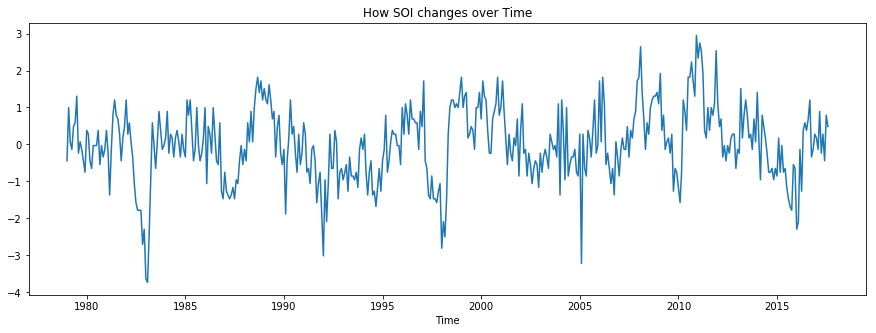
Let us put all four variables together and see how they are distributed or if there is any visual relationship.
i = 1
fig = pyplot.figure(figsize=(15,10))
for col in df.columns.tolist():
fig.add_subplot(len(df.columns.tolist()), 1, i)
df[col].plot()
pyplot.title(col, y=0.8, loc='right')
if i != len(df.columns.tolist()):
pyplot.tick_params(
axis='x', # changes apply to the x-axis
which='both', # both major and minor ticks are affected
bottom=False, # ticks along the bottom edge are off
top=False, # ticks along the top edge are off
labelbottom=False) # labels along the bottom edge are off
pyplot.xlabel('')
i += 1
pyplot.show()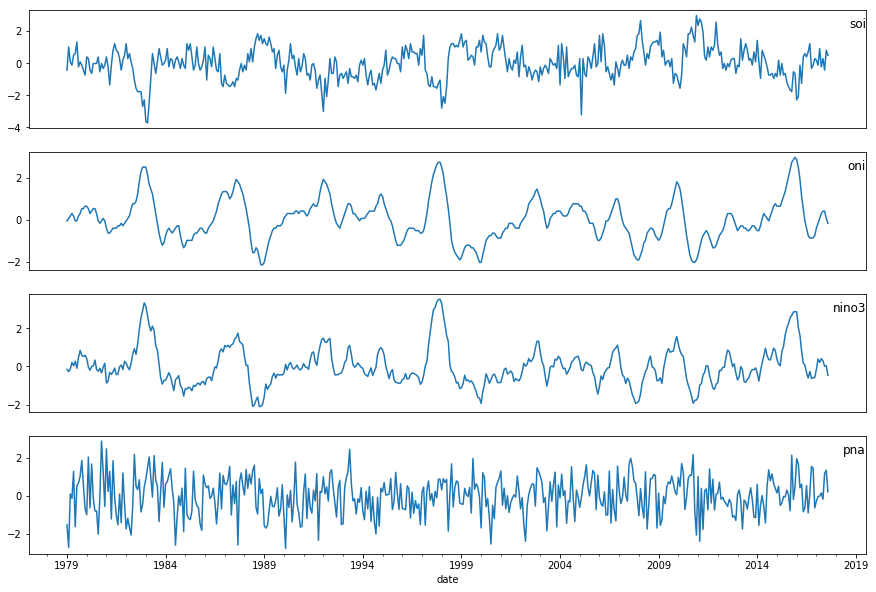
As we can see, there is some relationship between the input variables (i.e., oni, nino3, pna) and output variable, soi. For example, oni and soi look highly negatively correlated. We will cover how to model SOI using these variables in the time series analysis, but first let's look at how to bring in the last variable - precipitation.
Part 2. Correlation analysis
Global precipitation monthly mean is avaialble in raster format on ArcGIS online. In this part, we will cover how to indentify the most correlated (on time dimension) grid cell through lagged correlation analysis. There are two rationals behind this.
- In climate science, a phenomenon that is happening now could be a result of what has happend in the past. In other words, SOI of this month could be most correlated with the ONI of last month or the month before depending on the actual physical process.
- ENOS is a type of teleconnection which refers to climate anomalies being related to each other at large distances.
First, let us search and acess the precipitation data from ArcGIS Online.
data = agol.content.search('Global Monthly Precipitation 1979-2017')[0]
datadata_item = agol.content.get(data.id)Once the data is download to local, we can read it and visualize it through skimage and matplotlib to get a sense of what the data looks like. Because the spatial resolution is 2.5 by 2.5 degrees, there are 72 rows and 144 columns. The third dimension is the time dimension as the data contains monthly mean from 1970.1 to 2017.10, which is 466 months in total.
from skimage import io
import math
from scipy.stats.stats import pearsonr
from numpy import unravel_index
precipitation_path = os.path.join('.', 'data', 'precipitation.tif')
precip_full = io.imread(precipitation_path)
precip_full = np.flip(precip_full, 0)
# print the dimension of the precip_full, (lat, lon, time)
print(precip_full.shape)
# let's print out the first month/band of this data
pyplot.figure(figsize=(15,6))
pyplot.imshow(precip_full[:,:,0], extent=[-180, +180, -90, 90])(72, 144, 466)
<matplotlib.image.AxesImage at 0x1c2c385be0>
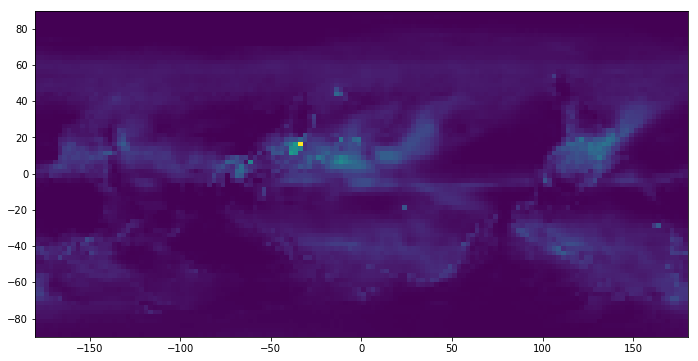
Before calculating the correlation, let's transform the precipitation monthly mean to precipitation anomaly, which a usually provides better signal than absolute precipitation. For short, anomaly means how much precipitation departs from what is normal for that time of year at a specific location. Let's say, we would like to know the anomaly of a specific grid in October this year. We need to compute the historial mean of October precipitation and then caculate its difference with value of this October.
# calculate the historical mean for each month
a = np.zeros(shape = (precip_full.shape[0], precip_full.shape[1], math.ceil(precip_full.shape[2]/12)*12))
a[:,:,0:precip_full.shape[2]] = precip_full
a = a.reshape(a.shape[0], a.shape[1], int(a.shape[2]/12), 12)
monthly_sum = np.sum(a, axis=2)
montly_mean_1_10 = monthly_sum[:,:,0:10]/a.shape[2]
montly_mean_11_12 = monthly_sum[:,:,-2:]/(a.shape[2] - 1)
monthly_mean = np.append(montly_mean_1_10, montly_mean_11_12, axis=2)
# calculate the difference
for i in range(a.shape[3]):
a[:,:,i,:] -=monthly_mean
# reshape the data back to its orginial dimension
a = a.reshape(a.shape[0], a.shape[1], a.shape[2]*a.shape[3])
# visualize the first month anomaly
pyplot.figure(figsize=(15,6))
pyplot.imshow(a[:,:,0], extent=[-180, +180, -90, 90])<matplotlib.image.AxesImage at 0x1c33362940>
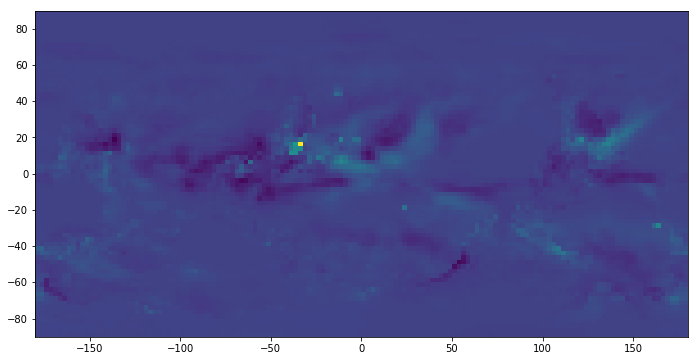
Now we have the anomaly. Let us calculate Pearson correlation coefficient between SOI and precipitation anomaly across all the grids based on a range of time lag from 0 to 5. The goal is the find the grid that has the greatest absolute Pearson correlation.
df.shape(464, 4)
lag = 5
fig, axs = pyplot.subplots(nrows=3, ncols=2, figsize=(14, 12))
fig.subplots_adjust(left=0.03, right=0.97, hspace=0.4, wspace=0.4)
for t in range(lag+1):
soi = df.values[t:,0]
soi = soi.reshape(soi.shape[0], 1)
precip = a[:,:,0:-4-t]
r2 = []
for i in range(precip.shape[0]):
for j in range(precip.shape[1]):
r2_index = pearsonr(soi, precip[i,j,:].reshape(precip.shape[2], 1))[0]
r2.append(r2_index)
r2_map = np.array(r2).reshape(precip.shape[0], precip.shape[1])
max_index = unravel_index(r2_map.argmax(), r2_map.shape)
im = axs.flat[t-1].imshow(np.abs(r2_map), extent=[-180, +180, -90, 90])
fig.colorbar(im, ax = axs[t//2, t%2])
# we only care only absolute correlation in this case
r2_map = np.abs(r2_map)
max_index = unravel_index(r2_map.argmax(), r2_map.shape)
axs.flat[t-1].set_title('lag=' + str(t) + '\n' + 'max_index=' + str(max_index) + '\n' + 'max_absolute_correlation=' + str(float("%.3f" % r2_map[max_index])))
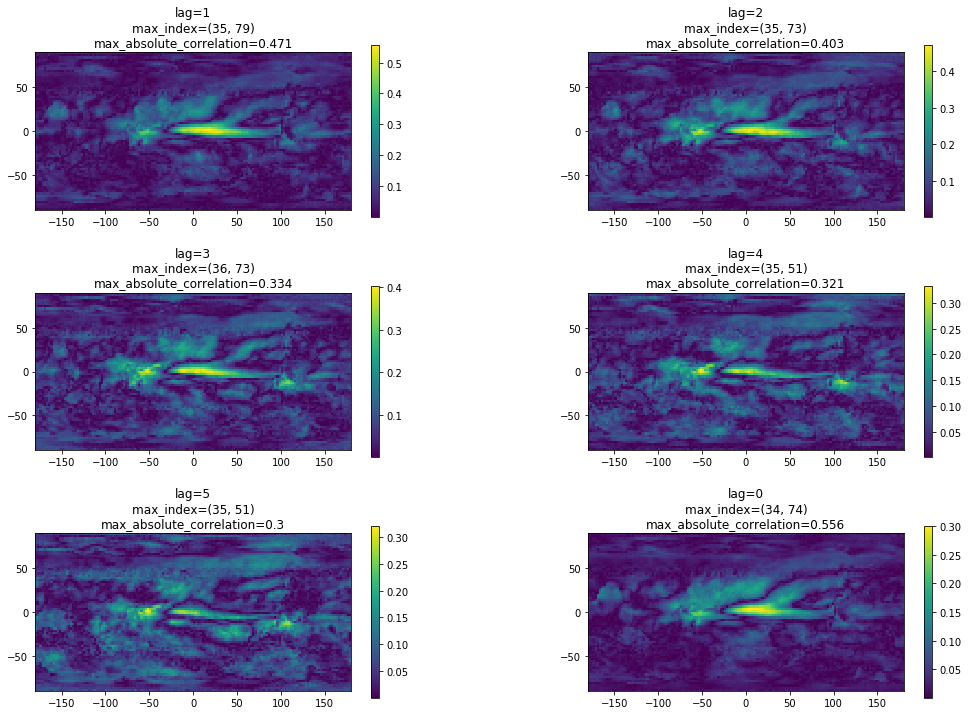
As can be seen, the largest correlation results from lag=0 at (row, column) = (34, 74). We will then take the precipitation anomaly of this grid and combine it with the other variables to predict SOI in another notebook.
Part 3. Time Series Analysis/LSTM
The third part of ENSO prediction focuses on time seris analysis. Here our SOI time series prediction problem is formulated as a regression problem and the idea is to use prior time steps to predict the next time step(s). Specifically, this analysis consists of three sections:
- Data cleanup and transformation: transform the raw data into format that supervised machine learning algorithms can take, and split out training and test datasets
- Model training: train a Long short-term memory (LSTM) neural network.
- Prediction and evaluation: evaluate the models on test dataset and plot the results.
Data cleanup and transformation
Time series data can be phrased as supervised learning if we think of by previous time steps as input variables and the next time step(s) as the output variable. Before we do any transformationm, let's first import all the necessary packages and take a look at what our data looks like.
%matplotlib inline
import os.path
import warnings
import numpy as np
from math import sqrt
from matplotlib import pyplot
from pandas import read_csv
from pandas import DataFrame
from pandas import concat
from pandas import datetime
from sklearn.metrics import mean_squared_error
from keras.models import Sequential
from keras.layers import Dense
from keras.layers import LSTM
from keras.models import load_model
warnings.filterwarnings('ignore')
def parser(x):
if x.endswith('11') or x.endswith('12')or x.endswith('10'):
return datetime.strptime(x, '%Y%m')
else:
return datetime.strptime(x, '%Y0%m')
enso_ready_path = os.path.join('.', 'data', 'enso_ready.csv')
df = read_csv(enso_ready_path, header=0, parse_dates=[0], index_col=0, date_parser=parser)
df.head()Using TensorFlow backend.
| soi | oni | nino3 | pna | precip | |
|---|---|---|---|---|---|
| date | |||||
| 1951-01-01 | 1.5 | -0.8 | -0.72 | -1.18 | NaN |
| 1951-02-01 | 0.9 | -0.5 | -0.43 | -2.11 | NaN |
| 1951-03-01 | -0.1 | -0.2 | -0.63 | -1.09 | NaN |
| 1951-04-01 | -0.3 | 0.2 | 0.00 | 0.47 | NaN |
| 1951-05-01 | -0.7 | 0.4 | -0.12 | 1.19 | NaN |
As precipitation data is not available until 1979, let's remove the first few rows, standardize each column by calcuting the z-score, and move soi (input variable) to the last column of the table.
start = 336
df = df.iloc[start:]
df = (df - df.mean()) / df.std()
cols = df.columns.tolist()
cols = cols[1:] + cols[:1]
df = df[cols]
df.head()| oni | nino3 | pna | precip | soi | |
|---|---|---|---|---|---|
| date | |||||
| 1979-01-01 | -0.059963 | -0.150376 | -1.537109 | 1.424196 | -0.441750 |
| 1979-02-01 | 0.056451 | -0.271512 | -2.725606 | 0.200227 | 0.997371 |
| 1979-03-01 | 0.172865 | -0.139364 | 0.080846 | -0.530831 | 0.072222 |
| 1979-04-01 | 0.289280 | 0.213033 | -0.148864 | -0.755133 | -0.133367 |
| 1979-05-01 | 0.172865 | 0.036835 | 1.269344 | -0.270530 | 0.483399 |
Most supervised learning algorithms require all input variables to be on the same row with its corresponding output variable. In SOI prediction, the goal is to use the variables (i.e., oni, nino3, pna, precip, and soi) of the previous time steps (e.g. 12) to predict the SOI of the next time steps (e.g. 3). Formally, the use of prior time steps to predict the next time step is called the sliding window approach (aka window or lag method) in time series analysis/prediction. Therefore, let's define a method that transforms panda time series into format that supervised learning algorithms can take.
"""
This method takes a time series and returns transformed data.
data: time series as pandas dataframe
n_in: number of previous time steps as input (X)
n_out: number of next time steps as output (y)
dropnan: whether or not to drop rows with NaN values
"""
def series_to_supervised(data, n_in=1, n_out=1, dropnan=True):
n_vars = 1 if type(data) is list else data.shape[1]
df = DataFrame(data)
cols, names = list(), list()
# input sequence (t-n, ... t-1)
for i in range(n_in, 0, -1):
cols.append(df.shift(i))
names += [('var%d(t-%d)' % (j+1, i)) for j in range(n_vars)]
# forecast sequence (t, t+1, ... t+n)
for i in range(0, n_out):
cols.append(df.shift(-i).iloc[:,-1])
if i == 0:
names += ['VAR(t)']
else:
names += ['VAR(t+%d)' % i]
# put it all together
agg = concat(cols, axis=1)
agg.columns = names
# drop rows with NaN values
if dropnan:
agg.dropna(inplace=True)
return aggNote that after transformation, there are some edges cases where the input or output variable could be NaN. For example, as data before 1979 is not available, there is no way to form a row for SOI of 1979. That's why there is a dropnan option is the method.
# specify the size of our sliding window and number of features
enso = df.values.astype('float32')
lag = 12
ahead = 3
n_features = 1
reframed = series_to_supervised(enso, lag, ahead)
reframed.head()| var1(t-12) | var2(t-12) | var3(t-12) | var4(t-12) | var5(t-12) | var1(t-11) | var2(t-11) | var3(t-11) | var4(t-11) | var5(t-11) | ... | var4(t-2) | var5(t-2) | var1(t-1) | var2(t-1) | var3(t-1) | var4(t-1) | var5(t-1) | VAR(t) | VAR(t+1) | VAR(t+2) | |
|---|---|---|---|---|---|---|---|---|---|---|---|---|---|---|---|---|---|---|---|---|---|
| 12 | -0.059963 | -0.150376 | -1.537109 | 1.424196 | -0.441750 | 0.056451 | -0.271512 | -2.725606 | 0.200227 | 0.997371 | ... | 0.061769 | -0.441750 | 0.638523 | 0.587453 | -0.678194 | -0.032382 | -0.750133 | 0.380605 | 0.277811 | -0.441750 |
| 13 | 0.056451 | -0.271512 | -2.725606 | 0.200227 | 0.997371 | 0.172865 | -0.139364 | 0.080846 | -0.530831 | 0.072222 | ... | -0.032382 | -0.750133 | 0.638523 | 0.411255 | -1.007778 | -0.076689 | 0.380605 | 0.277811 | -0.441750 | -0.647339 |
| 14 | 0.172865 | -0.139364 | 0.080846 | -0.530831 | 0.072222 | 0.289280 | 0.213033 | -0.148864 | -0.755133 | -0.133367 | ... | -0.076689 | 0.380605 | 0.522109 | -0.029240 | 2.028384 | -0.804978 | 0.277811 | -0.441750 | -0.647339 | -0.030572 |
| 15 | 0.289280 | 0.213033 | -0.148864 | -0.755133 | -0.133367 | 0.172865 | 0.036835 | 1.269344 | -0.270530 | 0.483399 | ... | -0.804978 | 0.277811 | 0.289280 | -0.194425 | -0.638245 | 0.269456 | -0.441750 | -0.647339 | -0.030572 | -0.030572 |
| 16 | 0.172865 | 0.036835 | 1.269344 | -0.270530 | 0.483399 | -0.059963 | 0.279107 | -1.636982 | -0.068382 | 0.586194 | ... | 0.269456 | -0.441750 | 0.405694 | -0.007215 | 1.658851 | -0.359143 | -0.647339 | -0.030572 | -0.030572 | -0.030572 |
5 rows × 63 columns
Model training
Now we have the data, let's define a method that trains a LSTM model. For the purpose of simplicity, we define a two layer neural network with one LSTM layer and one dense layer.
"""
This method takes training data and returns a LSTM model
train: training data
n_lag: number of previous time steps
n_ahead: number of next time steps
nb_epoch: number of epochs
n_neurons: number of n_neurons in the first layer
"""
def fit_lstm(train, n_lag, n_ahead, n_batch, nb_epoch, n_neurons):
# reshape training into [samples, timesteps, features]
X, y = train[:, :-n_ahead], train[:, -n_ahead:]
X = X.reshape(X.shape[0], n_lag, int(X.shape[1]/n_lag))
# design neural network architecture. This is a simple LSTM just for demo purpose
model = Sequential()
model.add(LSTM(n_neurons, batch_input_shape=(n_batch, X.shape[1], X.shape[2]), stateful=True))
model.add(Dense(n_ahead))
model.compile(loss='mean_squared_error', optimizer='adam')
# fit the NN
for i in range(nb_epoch):
model.fit(X, y, epochs=1, batch_size=n_batch, verbose=2, shuffle=False)
model.reset_states()
return modelLet's split our transformed data into training and test sets and feed the model training method. The first 80 precent will be used for training purpose and the last 20 percent will be using as test set. Note that in time sereis analysis, we don't do random shuffle because it's important to preserve time dependency/order.
values = reframed.values
n_train = int(len(values) * 0.8)
train = values[:n_train, :]
test = values[n_train:, :]
# fit a LSTM model with the transformed data
# model fitting can be very time-consuming, therefore a pre-trained model is included in the data folder
model_path = os.path.join('.', 'data', 'my_model.h5')
if not os.path.exists(model_path):
model = fit_lstm(train, lag, ahead, 1, 30, 30)
model.save(model_path)
else:
model = load_model(model_path)WARNING:tensorflow:From /anaconda3/envs/geosaurus/lib/python3.7/site-packages/tensorflow/python/framework/op_def_library.py:263: colocate_with (from tensorflow.python.framework.ops) is deprecated and will be removed in a future version. Instructions for updating: Colocations handled automatically by placer. WARNING:tensorflow:From /anaconda3/envs/geosaurus/lib/python3.7/site-packages/tensorflow/python/ops/math_ops.py:3066: to_int32 (from tensorflow.python.ops.math_ops) is deprecated and will be removed in a future version. Instructions for updating: Use tf.cast instead.
model.summary()_________________________________________________________________ Layer (type) Output Shape Param # ================================================================= lstm_4 (LSTM) (1, 30) 4320 _________________________________________________________________ dense_4 (Dense) (1, 3) 93 ================================================================= Total params: 4,413 Trainable params: 4,413 Non-trainable params: 0 _________________________________________________________________
Prediction and evaluation
Now let's apply the model to the test set and evaluate the accuracy for each of those three next time steps.
# predict the SOI values for next three time steps given a single input sample
def forecast_lstm(model, X, n_batch, n_lag):
# reshape input pattern to [samples, timesteps, features]
X = X.reshape(1, n_lag, int(len(X)/n_lag))
# make forecast
forecast = model.predict(X, batch_size=n_batch)
# convert to array
return [x for x in forecast[0, :]]
# make prediciton for a list of input samples
def make_forecasts(model, n_batch, train, test, n_lag, n_ahead):
forecasts = list()
for i in range(len(test)):
X = test[i, :-n_ahead]
# make forecast
forecast = forecast_lstm(model, X, n_batch, n_lag)
# store the forecast
forecasts.append(forecast)
return forecastsforecasts = make_forecasts(model, 1, train, test, lag, ahead)
# pring out the output for the first input sample
forecasts[0][-1.5042609, -1.4436339, -1.52989]
As mentioned in the very beginning, time series prediction is treated as a regression problem in our case, so let's compute mean square error (MSE) for each next time step.
def evaluate_forecasts(y, forecasts, n_lag, n_seq):
print('Evaluation results (RMSE) for each next tim step:')
for i in range(n_seq):
actual = [row[i] for row in y]
predicted = [forecast[i] for forecast in forecasts]
rmse = sqrt(mean_squared_error(actual, predicted))
print('t+%d time step: %f' % ((i+1), rmse))
# evaluate forecasts
actual = [row[-ahead:] for row in test]
evaluate_forecasts(actual, forecasts, lag, ahead)Evaluation results (RMSE) for each next tim step: t+1 time step: 0.795490 t+2 time step: 0.843505 t+3 time step: 0.907717
To to a better understanding of the prediction result, let's plot it out and compare with with the original data.
# plot the forecasts in the context of the original dataset, multiple segments
def plot_forecasts(series, forecasts, n_test, xlim, ylim, n_ahead, linestyle = None):
pyplot.figure(figsize=(15,8))
if linestyle==None:
pyplot.plot(series, label='observed')
else:
pyplot.plot(series, linestyle, label='observed')
pyplot.xlim(xlim, ylim)
pyplot.legend(loc='upper right')
# plot the forecasts in red
for i in range(len(forecasts)):
# this ensures not all segements are plotted, it is plotted every n_ahead
if i%n_ahead ==0:
off_s = len(series) - n_test + 2 + i - 1
off_e = off_s + len(forecasts[i]) + 1
xaxis = [x for x in range(off_s, off_e)]
yaxis = [series[off_s]] + forecasts[i]
pyplot.plot(xaxis, yaxis, 'r')
pyplot.show()
plot_forecasts(df['soi'].values, forecasts, test.shape[0] + ahead - 1, 0, 500, ahead)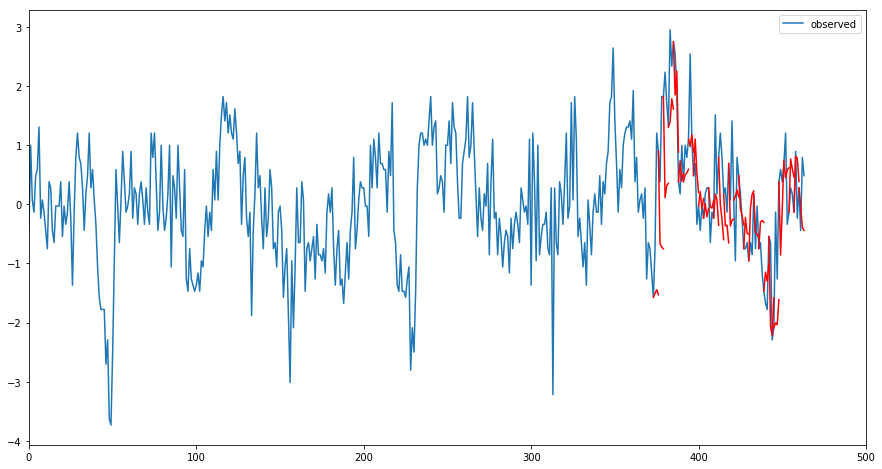
Here the blue line is the ogriginal time series, the red line is the prediction results. As we can see, it is doing a reasonable job. ENSO prediction is considered one of the most difficult task in climate science, but with more sophisicated modeling tuning and architecture desgin, we believe better results could be achieved.
Conclusion
In this notebook, we observed how ENSO prediction can be done with the aid of ArcGIS API for Python. We started with a correlation to find the most correlated grid in terms of precipitation. And then we performed time series analysis and LSTM to predict SOI based a few input variables including precipitation from prior time steps. With a basic LSTM example, we are able to acheive a reasonable accuracy as ENSO prediction is one of the most challenge tasks in climatology.
